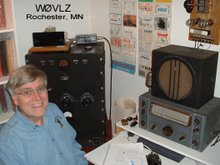This antenn
 a is a big improvement over my 105' endfed wire. Last night on 80 CW running only about 10 watts I worked KK1K (VT), VE7SL (BC) and VE3AWA (ONT). All gave me good signal reports and had no trouble with the QSOs. In addition VE7SL reported I went from s6-s7 to unreadable when switching back to the endfed wire. VE3AWA reported that I went from s9 plus to s8 when switching to the endfed wire.
a is a big improvement over my 105' endfed wire. Last night on 80 CW running only about 10 watts I worked KK1K (VT), VE7SL (BC) and VE3AWA (ONT). All gave me good signal reports and had no trouble with the QSOs. In addition VE7SL reported I went from s6-s7 to unreadable when switching back to the endfed wire. VE3AWA reported that I went from s9 plus to s8 when switching to the endfed wire.I also checked my antenna performance used the Reverse Beacon Network at http://www.reversebeacon.net .This is a network of receivers/computers connected to the internet. They auto log the frequency and signal level of any CQs heard. By calling CQ using both the vertical and the endfed wire I got a good idea on how the two antennas compare. The network consistently logged me whe
 n I used the vertical and never heard me when I used the endfed wire. At the locations on the Reverse Beacon Network, the vertical was the clear winner. But there were no reverse beacon stations in MN, WI or IA. My endfed wire might have done better if evaluated using nearby reverse beacon stations locations.
n I used the vertical and never heard me when I used the endfed wire. At the locations on the Reverse Beacon Network, the vertical was the clear winner. But there were no reverse beacon stations in MN, WI or IA. My endfed wire might have done better if evaluated using nearby reverse beacon stations locations.I was asked about my radial system. I have eight 30' insulated wire radials stapled in the grass. 30' seems short, I expected to need 67' (1/4 wave on 80) long
 radials. I measured the resonant frequency of the radial system as I would an 8 element fan dipole with two 4 element halves. 30' seemed to be right. Velocity factor must have a big impact on the len
radials. I measured the resonant frequency of the radial system as I would an 8 element fan dipole with two 4 element halves. 30' seemed to be right. Velocity factor must have a big impact on the len gth of ground mounted radials.
gth of ground mounted radials.This new vertical should definitely help my AWA QSO Party scores.













